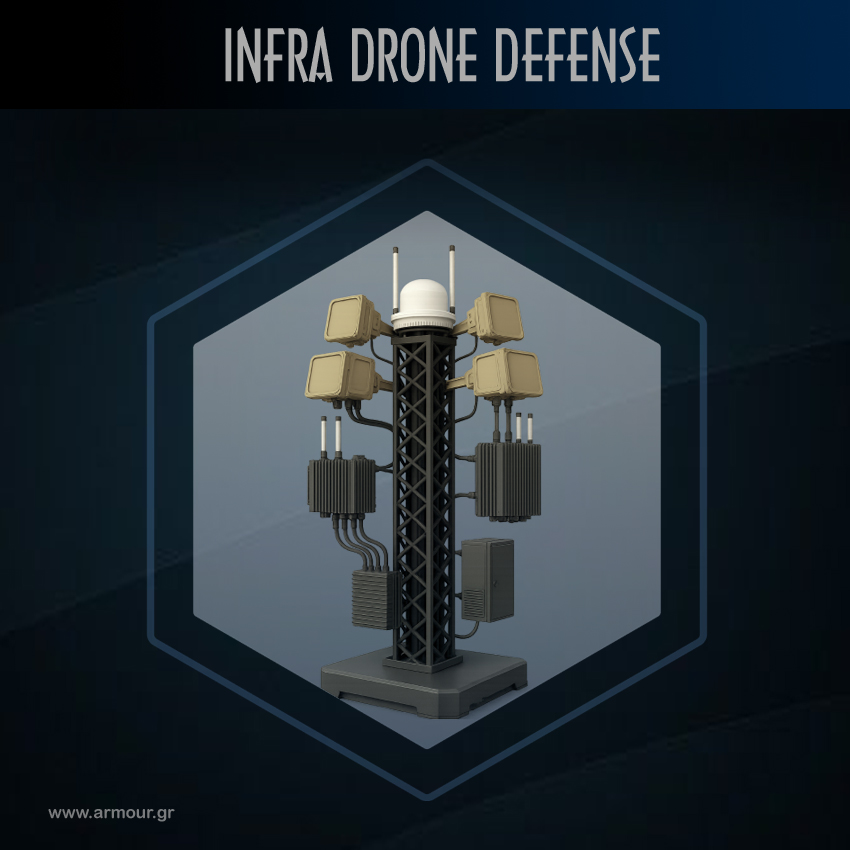Drones Countermeasures
Defending against drones involves a multi-layered approach that integrates various technologies and strategies.
Anti-drone systems, also known as Counter-Unmanned Aerial Systems (C-UAS), typically include the following components and measures:
1. Detection Systems
- Radar Systems: These can detect drones at long ranges by identifying their radio frequency (RF) signatures.
- RF Detectors: These can identify the signals between the drone and its controller.
- Electro-Optical (EO) and Infrared (IR) Cameras: These provide visual confirmation and tracking of drones.
- Acoustic Sensors: These can identify drones by the unique sound of their propellers.
2. Identification Systems
- Signal Analysis: Helps in identifying the type and model of the drone.
- Database Comparison: Uses a database of known drone types and their characteristics for identification.
- Artificial Intelligence (AI): AI algorithms can help in distinguishing drones from birds and other objects.
3. Jamming and Interference
- RF Jammers: These disrupt the communication link between the drone and its controller, causing the drone to lose control.
- GPS Spoofing: This involves sending fake GPS signals to misguide the drone or force it to land.
4. Kinetic Measures
- Net Guns: These can capture drones in mid-air.
- Projectile Systems: Traditional firearms or specially designed projectiles can be used to disable drones.
- Laser Systems: High-energy lasers can burn and disable drone components.
5. Directed Energy Weapons (DEWs)
- Microwave Systems: These can disrupt the drone's electronics without physical contact.
- High-Power Electromagnetic (HPEM) Systems: These can fry the drone's electronic circuits.
6. Cyber Measures
- Hacking: Taking control of the drone by exploiting vulnerabilities in its software.
- Data Interception: Intercepting and altering the data being sent to and from the drone.
7. Physical Barriers
- Drone Shields and Nets: These can be deployed around sensitive areas to physically prevent drones from entering.
8. Policy and Legal Measures
- Regulations and No-Fly Zones: Establishing and enforcing no-fly zones around critical infrastructure.
- Licensing and Tracking: Requiring drones to have identification beacons and tracking capabilities.
9. Training and Preparedness
- Training Security Personnel: Ensuring that security forces are trained to recognize and respond to drone threats.
- Drills and Simulations: Regular drills to prepare for drone incursions.
10. Integration and Coordination
- Command and Control Systems: Centralized systems to integrate all detection and mitigation measures
- Collaboration with Agencies: Working with aviation authorities, law enforcement, and military to ensure a comprehensive approach
In summary, an effective anti-drone system requires a combination of detection, identification, mitigation, and neutralization technologies, along with robust policies and trained personnel. By integrating these components, it's possible to create a comprehensive defense against drone threats.
To effectively detect and track drones, a multi-faceted approach involving various types of equipment and frequencies is necessary.
Analysis of the components and characteristics of a robust detection system for counter-drone operations
1. Radar Systems
Equipment:
Surveillance Radars: These are used to detect and track drones over a wide area.
3D Radars: Capable of providing altitude information in addition to range and azimuth.
Phased Array Radars: Offer rapid beam steering and can track multiple drones simultaneously.
Frequencies:
X-Band (8-12 GHz): Commonly used for short-range surveillance due to its high resolution.
S-Band (2-4 GHz): Suitable for medium-range detection, providing a balance between range and resolution.
C-Band (4-8 GHz): Also used for medium-range detection with slightly higher resolution than S-Band.
2. RF Detectors
Equipment:
RF Spectrum Analyzers: Monitor the electromagnetic spectrum for signals used by drone controllers.
Direction Finders: Determine the direction of the detected RF signals.
Frequencies:
2.4 GHz and 5.8 GHz: Common frequencies used by most commercial drones for communication.
433 MHz and 915 MHz: Frequencies used by some long-range and specialized drones.
3. Electro-Optical (EO) and Infrared (IR) Cameras
Equipment
EO Cameras: High-resolution day cameras that provide visual tracking and identification.
IR Cameras: Thermal cameras that detect the heat signature of drones, useful for night operations and in adverse weather conditions.
Frequencies
EO Cameras: Operate in the visible spectrum (400-700 nm).
IR Cameras: Operate in the mid-wave infrared (MWIR, 3-5 µm) and long-wave infrared (LWIR, 8-12 µm) bands.
4. Acoustic Sensors
Equipment
Microphone Arrays: Detect the unique sound patterns produced by drone propellers and motors.
Frequencies
Audio Frequencies: Typically within the range of 20 Hz to 20 kHz, focusing on the specific frequencies generated by drone engines and propellers.
5. Integration and Data Fusion
Command and Control (C2) Systems
Centralized Software Platforms: Integrate data from radar, RF detectors, EO/IR cameras, and acoustic sensors to provide a comprehensive situational awareness and decision-making interface.
Machine Learning Algorithms: Enhance detection and identification accuracy by distinguishing drones from other objects like birds.
Detection Process Workflow
1. Initial Detection: Radars and RF detectors provide the first line of detection, identifying potential drone threats at long ranges.
2. Confirmation and Identification: EO/IR cameras and acoustic sensors confirm the presence of a drone and help identify its type and intent.
3. Tracking: Integrated systems continuously track the drone, providing real-time updates on its position and movement.
4. Data Fusion and Analysis: Data from all sensors is fused to give a coherent picture, allowing operators to make informed decisions about the threat level and appropriate countermeasures.
Environmental and Operational Considerations:
Urban Environments: High levels of RF noise and physical obstructions may require more sophisticated signal processing and alternative detection methods, such as acoustic sensors.
Rural and Open Areas: Long-range radar and RF detection systems are more effective due to fewer obstructions and lower RF noise.
Weather Conditions: EO/IR cameras and radars must be able to function effectively in various weather conditions, including rain, fog, and low visibility.
In summary, a comprehensive drone detection system integrates multiple sensor types operating across various frequencies to ensure reliable drone detection, identification, and tracking.
By leveraging the strengths of each technology and fusing their data, these systems can effectively address the diverse challenges posed by drone threats.
COMPLETE SOLUTION - MILITARY and/or GOVERNMENTAL USE ORIENTED
After a careful examination of (a) our Principals' needs in regard to the anti-drone protection (for anti-espionage, anti-cyber/hacking, anti-provocative and anti-terrorism reasons), (b) the various existing systems in the market, integrating various technologies and (c) the related prices of the same, we propose specific subsystems and integrations, either in a minimal/cost-effective and tailored made solution according to defense demands and without the need for drone or controller localization, but with the need, not a drone to approach our clients' valuable premises and/or assets, or in a more intellectual and complete approach drone(s) detection/neutralization and drone controller localization for detention purposes as follows,
(a) We do not want the enemy or the drone operator to detect our anti-drone squad team.
(b) We want to know the exact position of the drone(s) and/or drone(s) operator and neutralize them/chase him/her respectively.
(c) We want to have the selection of directional or omnidirectional low or high power jamming depending on the operations environment. We want to defend a wide area (12 Km from A to B):
Minimal Solution
One portable RF Spectrum Detection System device for general directional passive drone detection and early warning in order other active devices (360 degrees active detection Radar to be automatically turned on and locate the exact drone(s)' position and in case we do not want to actively/continuously transmit with the radar (i.e. economy / devices overloading avoidance purposes, undercover operations etc.)
OR
Three portable devices RF Spectrum Detection Systems for precise positional passive drone(s) detection and drone Controller detection in case we want to operate completely undercover and have the exact location of the enemy.
Combined with
One portable device 360 degrees active detection radar (in combination with device RF Spectrum Detector) for precise positional active drone detection and that will be automatically turned on and locate the drone(s) (in case we do not want to actively / continuously transmit with the radar). Additionally, the radar can detect UAVs at longer distances and especially in cases that the UAVs do not transmit any RF (flying to predefined targets position etc.)
AND
One portable device of low power uni-directional RF jammer that will be automatically turned-on / aligned with the target upon drone detection within our security perimeter (in case we do not want to affect other directions and/or friendly forces to other directions around us).
AND
One portable device of omni directional RF jammer that will be automatically turned- on upon drone detection within our security perimeter, in case of a multi threat scenario and with no danger of friendly forces interference nearby.
OR
One Mobile High Power omni-directional vehicle RF jammer that will be automatically turned-on upon drone detection within our security perimeter, in case of a multi threat scenario and with no danger of friendly forces nearby, or in case we need whatever be the case NOT TO ALLOW ANY DRONE TO FLIGHT WITHIN OUR PROTECTED ZONE.
AND
Rugged Computer & Monitors and life time Software support for all devices integration and control.
Optional
One Electro Optical day/night long range Cameras System if we want to have a visual aspect of the drones and the environment and a close cooperation with the 360 degrees active radar system for live targets monitoring and optical classification by the Controller
MINIMAL SOLUTION - PRIVATE USE ORIENTED
We do not need to know the exact position of the drone(s) and/or drone(s) operator. We want to defend a narrow area (i.e. up to 300-400m from A to B). We do not want any drone to approach our valuable premises / asset and avoid any espionage, hacking, criminal act and disturbances.
One portable RF Spectrum Detector device for general directional passive drone detection and early warning
Combined with
One portable device of omni-directional RF jammer that will be automatically turned-on upon drone detection within our close security perimeter, in case of a multi threat scenario and with no danger of friendly forces nearby. Also, if we want to defend a narrow area (i.e. up to 300-400 m from our valuable premises / assets) at an urban and close space environment.
AND
Rugged Computer & Monitors and life time Software support for all devices integration and control.








